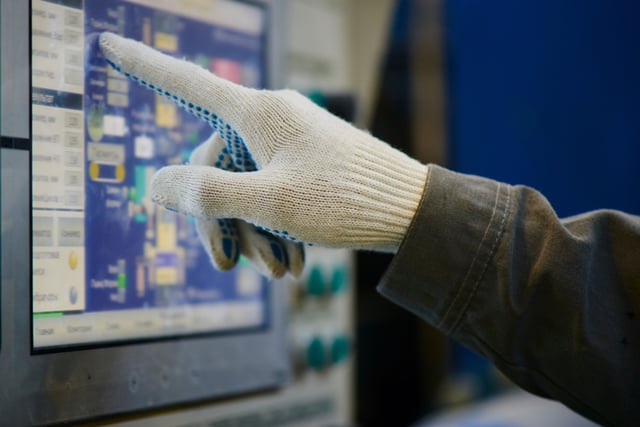The importance and benefits of an effective HMI for industrial automation applications.
Whether you’re familiar with a human-machine interface (HMI) or not, there are plenty of reasons why a good one has become a critical differentiator in the industrial automation world. Dreaming up a competitive platform simply isn’t good enough nowadays – it needs to put the user first, before any specific features or elegant visual elements.
Let’s look more closely at what exactly a human-machine interface is and why it’s essential in many modern-day industrial applications.

The fundamentals of industrial HMIs
An HMI is a state-of-the-art solution – either software, hardware, or a marriage of the two – that allows for seamless communication between users and connected equipment. This happens by way of making critical data elements, controls, and feedback easier to transmit, translate, and track. While “knowledge is power” is a term that might make one cringe slightly, it perfectly sums up what an industrial HMI is capable of: more efficient production through greater context and user safety.
There are many examples. It could be the oven controls in a large-scale commercial kitchen or the process feedback for a complex manufacturing line. Regardless of the use case, there are significant differences between the design and development of industrial HMIs versus consumer devices or even smart office products.
The relationship between an HMI and industrial automation
An HMI-enabled device typically boasts a clean-cut, no-nonsense user interface (UI). This, combined with reliable performance, user safety, and seamless connectivity to other industrial machinery, translates directly to an ideal user experience (UX). The right software, hardware, and optimal accessibility enable for a more effective, informed way of working, whether inputting commands to high-powered equipment via a multi-touch interface or sending crucial information to a production line.
The interactivity between the user, hardware, and software needs to flow in a way conducive to a reduced margin of error, less stress for users, and utmost confidence in the technologies utilized. That last point is important because if workers don’t trust the HMI they’re using, they’ll find ways to work around it, potentially causing loss of productivity, violation of company protocols, or even safety issues. Therefore, good design – one that puts the user first – should be a top priority to embedded systems developers and industrial clients alike.
Benefits of HMIs in industrial environments
Let’s walk through a list of practices and benefits directly associated with a well-thought-out HMI implementation that considers UX equal to software integration and optimization:
- Better organized content on screen doesn’t overwhelm or frustrate the user
- Reduced scrolling and highlighting of critical data elements improves focus
- Optimal user navigability, through screens and menus, is especially important for complex machinery applications
- Improved safety/risk-awareness with prioritized alerts, warnings, alarms, and otherwise
- Developer testing and refinements to optimize UX/UI in specific environments
- Better UX results in more efficient, productive, and well-informed equipment operators
- Streamlined inputs for lights, equipment, and heavy machinery saves operator time
- Lower operating costs for employers through QA/time savings/improved efficiency
- Easier to divvy up responsibilities and optimize labor without stressing employees

Types of HMI screens
There are three commonly implemented human machine interface techniques for industrial automation use cases. The first, known as a pushbutton replacer, centralizes multiple input functions into one easily accessible location, usually a menu or widget on a touchscreen. The second, a data handler, provides a continuous organized stream of data for use in specific applications (it’s also widely used in various forms of reporting). Lastly, there’s the overseer HMI device which, as the term implies, is more complex in nature (but hopefully not the case in terms of execution and the subsequent user interface and experience). This third technique helps to manage and organize an umbrella of connected systems.
Ideal use cases for HMI in industrial automation
If an embedded developer is creative and diligent enough with respect to client operations and needs, there’s almost no limit on what an HMI device can be used for in industrial automation applications.
Here are just some of the many potential implementations:
- Vehicle manufacturing
- Fabrics and textiles
- Electronics assembly lines
- Quality assurance and testing departments
- Packaging, shipping, receiving, and inventory
- Food services and restaurants
- Vehicle operations (such as forklifts) and plant navigation
- Security, safety, and operational compliance
- Medical devices in healthcare facilities
This is the tip of the iceberg when it comes to effective industrial user experience and developers are just getting started when it comes to emerging technologies, IoT connectivity, and hardware capabilities. Expect to see continued innovation, optimization, and client adaptation as the months and years go by.
Explore our very own development solutions for industrial automation HMIs today:
.png?width=180&height=67&name=Crank-AMETEK-HZ-Rev%20(4).png)


